Hello, I’m Mob. I’m a Unity beginner working on the Negolove team at SKOOTAGAMES. Usually, I’m just a person who casually makes games and goes home, but this time I’ve been assigned to report on the Tokyo Indie Game Summit (TIGS2025).
Writing articles isn’t originally my responsibility, but before I knew it, I had become a special correspondent for event reports… Well, it’s not a bad thing, so I’ll do my best to write this time as well.
This time, I want to focus on “operability that anyone can achieve” and introduce the indie games that caught my eye. Even seemingly simple controls may reveal deep thought and game mechanics hidden behind them, allowing us to feel the depth of game development once again. They say true refinement lies within simplicity, and the games I’m introducing this time are perfect examples of that. Now, let’s take a look.
鼻と花:スニファーの喜び―どこかなつかしい分かりやすさ

First up is 「鼻と花:スニファーの喜び」. The reason I noticed this game was that it gathered quite a few votes at the TIGS2025 voting awards. I thought, “There must be a reason everyone is paying so much attention to this,” so I decided to give it a try.
What I found particularly interesting while playing was, without a doubt, the controls and stage design.
The game’s controls are seemingly simple. You move the protagonist, who is shaped like a nose, to explore a wide map, but there is an interesting constraint here. The protagonist loses oxygen every time they move or take action. To replenish this, you need to get close to the flowers blooming all over the map and inhale. These flowers also serve as checkpoints, adding tension to the gameplay.
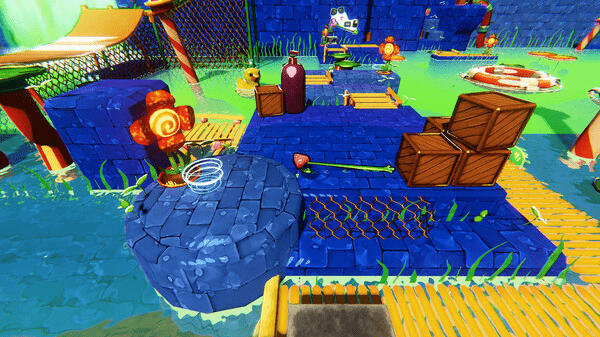
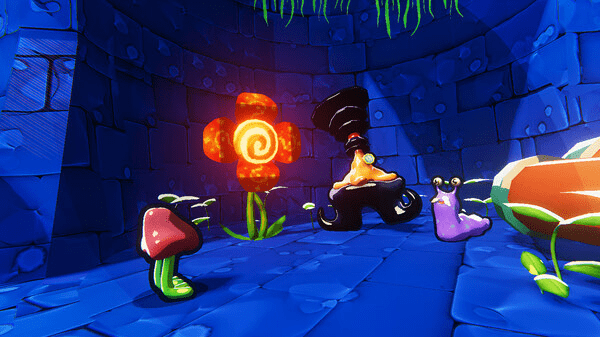
However, the true charm of this game lies beyond the basic actions of “moving and jumping.” The protagonist can stretch their limbs and leap forward like rubber, or break obstacles that resemble boxes in front of them. The unique visual style combined with the bouncy control feel is genuinely enjoyable.
What I appreciated most was that these controls were designed to be intuitive and easy to understand. Along with this operability, the game was filled with various obstacles and gimmicks. Simply put, within the structure of “a limited time to move” and “obstacles that hinder that,” the unique control feel provided a sense of accomplishment that kept the gameplay engaging, even if you were just traversing the map.
Personally, this map design reminded me of the gameplay I enjoyed on the “Nintendo 3DS,” evoking a sense of nostalgia. In a way, this intuitive operability may have been influenced by past games that had a simplicity allowing anyone to play.
By the way, just a little side note, the title of this game is also quite impressive. “鼻と花” is such a cleverly chosen name that it feels like it was intentionally crafted. When I asked the developer, they said it had nothing to do with the original title “NASAL NOMAD SNIFFER’S DELIGHT,” and it was an idea that emerged as a punchline during the localization process. I felt it was a very excellent choice that best represents this game, despite its simplicity.
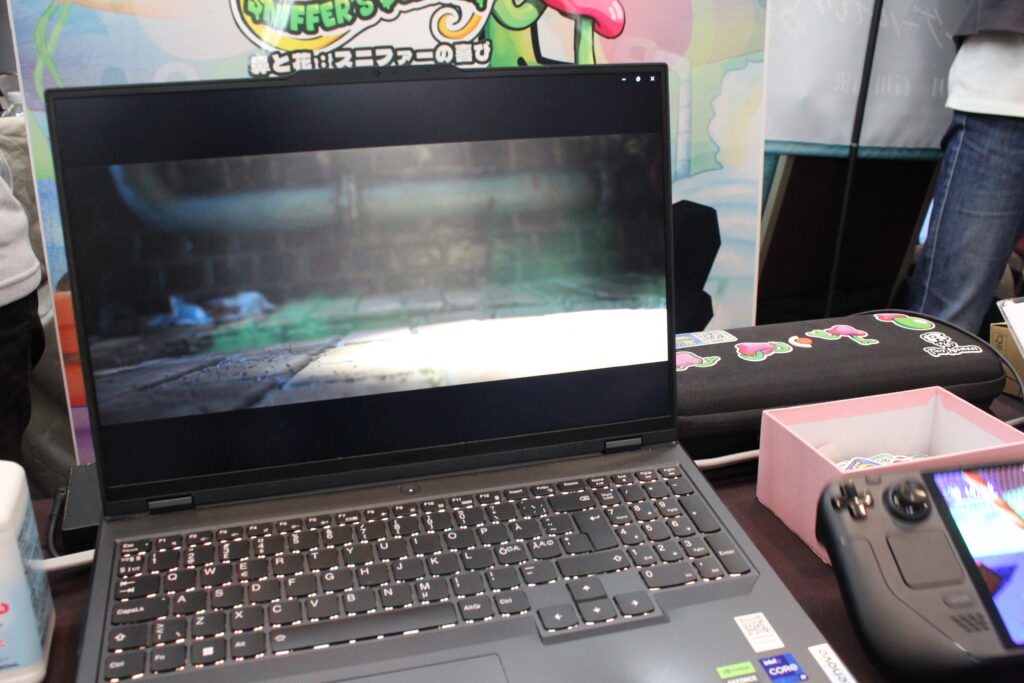
Additionally, through conversations with the developers, I learned about the origins of this game. It seems that the team was originally formed during a game jam, and they won at that game jam event, which sparked the development. They are currently progressing the project towards a product release.
There are truly various cases in indie games, but I feel the greatest charm lies in when a chance born from such coincidences is delivered to us as a game we can enjoy.
This “鼻と花” seems to have missed out on winning the TIGS award this time, but judging by its popularity at the venue, I believe it will become a beloved game for many players once it is released. Personally, I am looking forward to its release date.
I Write Games Not Tragedies―ノベル+リズム+叫ぶ(?)

Next up is 「I Write Games Not Tragedies」. What caught my eye first was its unique art style. As introduced on the Steam page, this game is heavily influenced by the emo style and goth subculture from the UK. The rough art style that is rarely seen and the microphone placed next to the laptop piqued my interest, prompting me to play it right away.
When I was first introduced to this game, I heard it described as “a combination of a narrative novel and a rhythm game.” The combination of a novel and a rhythm game was somewhat unfamiliar, but it wasn’t far from my expectations. The controls were the same.
This game is structured with about 70% narrative and 30% rhythm game, following the typical format of a novel game, where story progression through clicks occupies the main part of the gameplay. The rhythm game part, while varying slightly by section, was generally close to a format where you input notes using three buttons. In terms of difficulty, it was not particularly hard, and it was a simple and gentle game that could be played without special control instructions.
The story revolves around Ash, a music-loving adolescent protagonist, who grows through conversations and events with those around them. While somewhat typical, it deals with a rich theme that is not often seen in recent games. I perceived it as a growth drama where the protagonist, trapped by their solid values and hobbies, finds it difficult to accept others and gradually grows through interactions with the people around them.

They definitely look like a character with a unique personality.
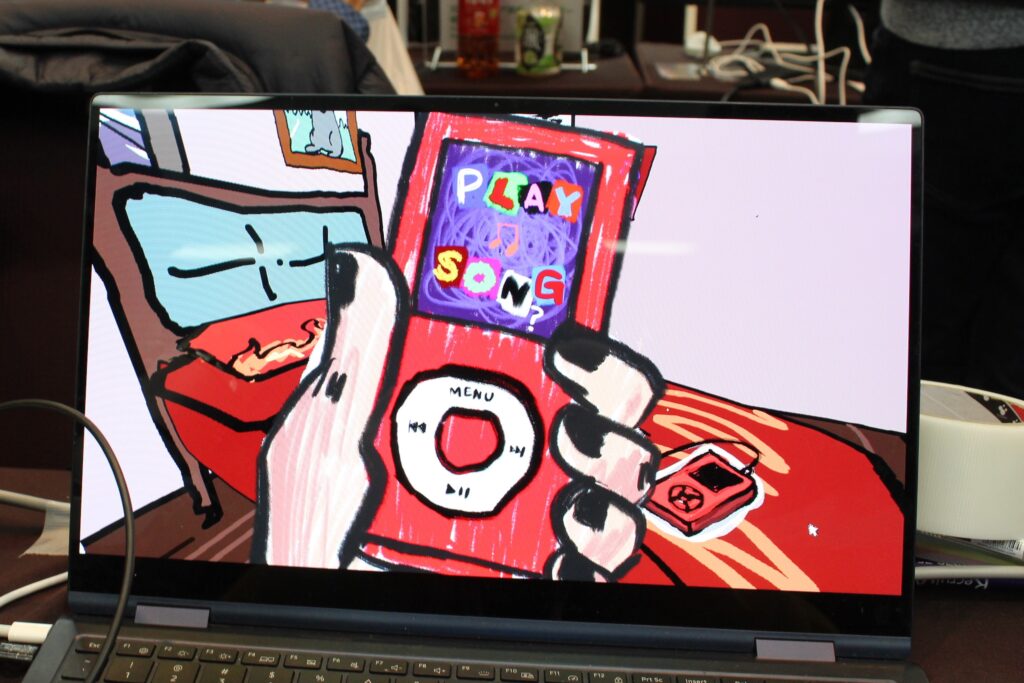
The story progresses from Ash’s perspective, that of a young adolescent, which gives it a somewhat teen drama-like impression. However, since it depicts the process of growing into adulthood, the heavy dialogue and themes that seep through are well-handled in this game. In simple terms, we could indirectly feel what the creator’s “nostalgia” is through this game.
As mentioned earlier, this game is structured with about 70% narrative and 30% rhythm game, with each part serving different roles. The narrative primarily handles the progression of the story, starting with the introduction and explanation of the protagonist and surrounding characters, and narrating many elements such as the progression of events and interactions with the environment, as well as the protagonist’s psychology.
In the rhythm game part, based on the understanding of the protagonist’s psychology and the nature of events from the preceding narrative part, unique rock-style music plays, providing moments to focus more on the lyrics and the protagonist’s psychology. Finally, there is a unique system called the “Scream part,” where you use a connected microphone to scream and earn scores. This is truly what rock and roll is about.

I must mention that overall, the music was fantastic. I wanted to purchase the audio tracks even before the game was released. I usually don’t listen to genres like emo rock, but despite that, the moment I heard the music from this game, I felt more impressed than when I listened to any other game music this time.
Although I felt a bit embarrassed to scream in the scream part and couldn’t raise my voice, I thought it was nice that I felt like I became Ash’s companion by screaming along. If it is released in the future, the music will undoubtedly be the most anticipated aspect.
In my conversation with the developers, I heard about their future release plans. It seems that the current Steam page states that Japanese is not supported, but the version I played at the event showed an excellent level of localization that posed no issues for gameplay. Of course, there was a slight translation-like atmosphere, but from my perspective, it would feel lonely if a game of this genre and thematic nature didn’t have that kind of flavor. I expressed my hope that they would support even more languages. The developers mentioned they are considering it, so I have high hopes that in the future, it will be playable in more languages, including Chinese and Korean.
FREEZIA―シンプルさの中に潜む不穏な余韻

Next up is 「FREEZIA」. In this puzzle action game, you play as the artificial intelligence “Freesia,” managing the frozen sleep of humanity and stabilizing the temperature of sleep pods.
The puzzle mechanics of this game were very simple. The goal is to adjust the temperature so that the people in the frozen sleep devices can sleep at the appropriate temperature. Specifically, players can raise or lower the temperature using the up and down arrow keys while watching the battery-shaped temperature display screen shown in front of them through the protagonist, Freesia. When the temperatures are aligned with the appropriate line, a countdown for “ALL OK” begins for temperature checking, and you win if no problems occur before the countdown ends.
At first, it was merely a puzzle format of matching the battery numbers using the arrow keys, but as the game progresses, capsules that automatically raise the temperature are added, gradually increasing the difficulty. That is the puzzle aspect of this game.
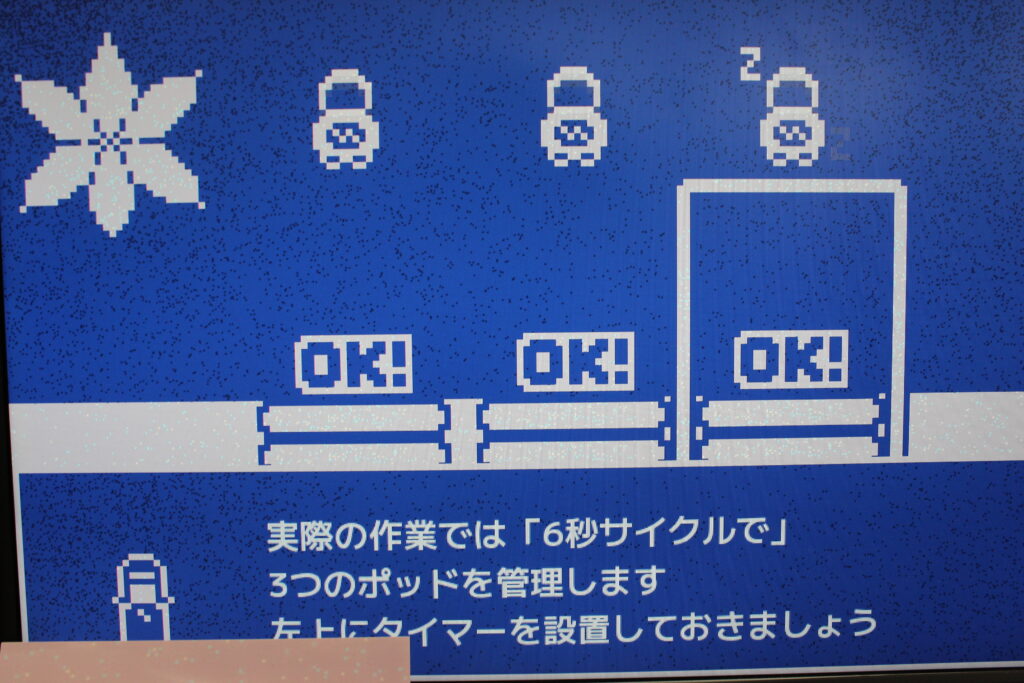
There were hardly any special points in the control method itself. What I mentioned above is almost everything, but with the addition of capsules, a function to switch temperatures is expected to be added in the future.
However, the near-futuristic setting and the unique premise of adjusting the temperature of frozen sleep devices, combined with the extremely simple screen composition and design, made this game not look like a “normal puzzle game” at all. The slightly dark, dystopian world view intertwined with simple controls creates an indescribable sense of discomfort that lingers throughout the gameplay.
In simple terms, the gameplay of merely adjusting the number of blocks is set against a backdrop where people could freeze to death or die from overheating, and this unpleasant world view’s system stimulates unnecessary imagination the more you play, leaving a deep impression on me. Therefore, even though I had already grasped the puzzle aspect of this game through a short play, I wholeheartedly decided, “I will definitely buy this game when it comes out.”
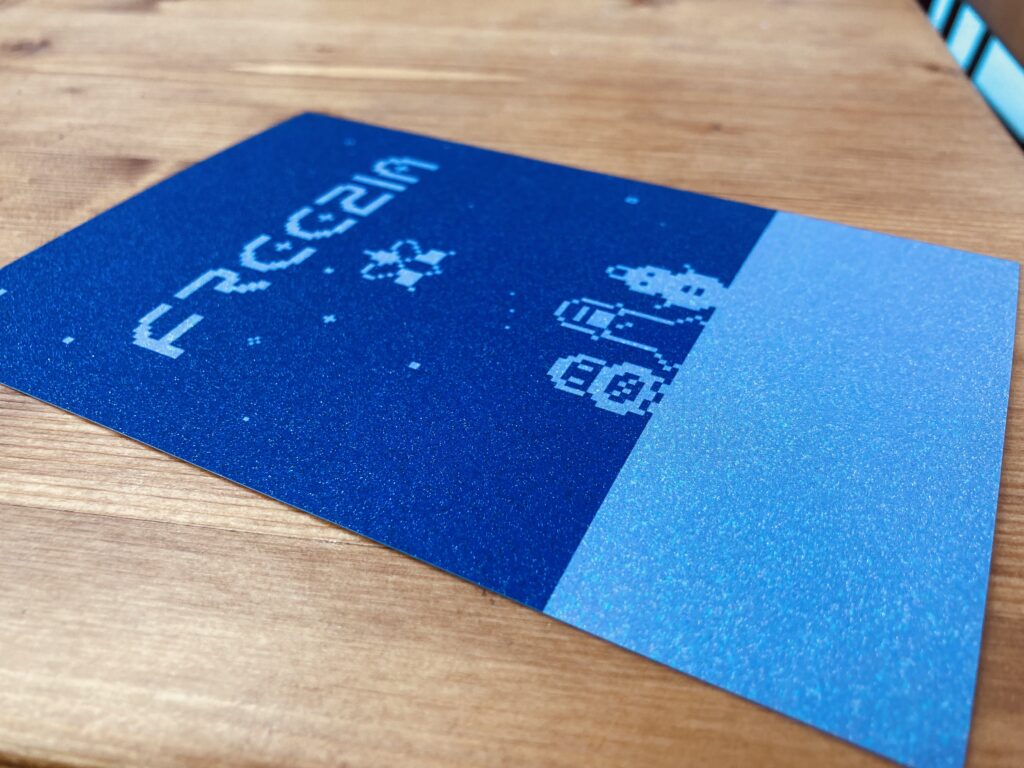
Like the explained gameplay and world view, what caught my eye at this event was the postcards distributed at the booth. Despite the game design being fundamentally composed of just two colors, the postcards handed out felt incredibly rich.
Upon closer inspection, the postcards were made of a special material that sparkled like glitter, and the glossy finish harmonized with the deep blue screen, creating an illusion as if stars were twinkling. When looking closely at the game screen, there were constant particle-like glitches displayed, so perhaps they focused on such points. In any case, these postcards made of this special material stood out distinctly among those distributed at other booths.
This work was one that taught me a lot from its simple gameplay, but I also learned a great deal from the attention to detail and commitment to such finer points. I look forward to seeing you at other events, including future developments.
A Passing in the Night―10分の散歩が生み出す不思議な体験
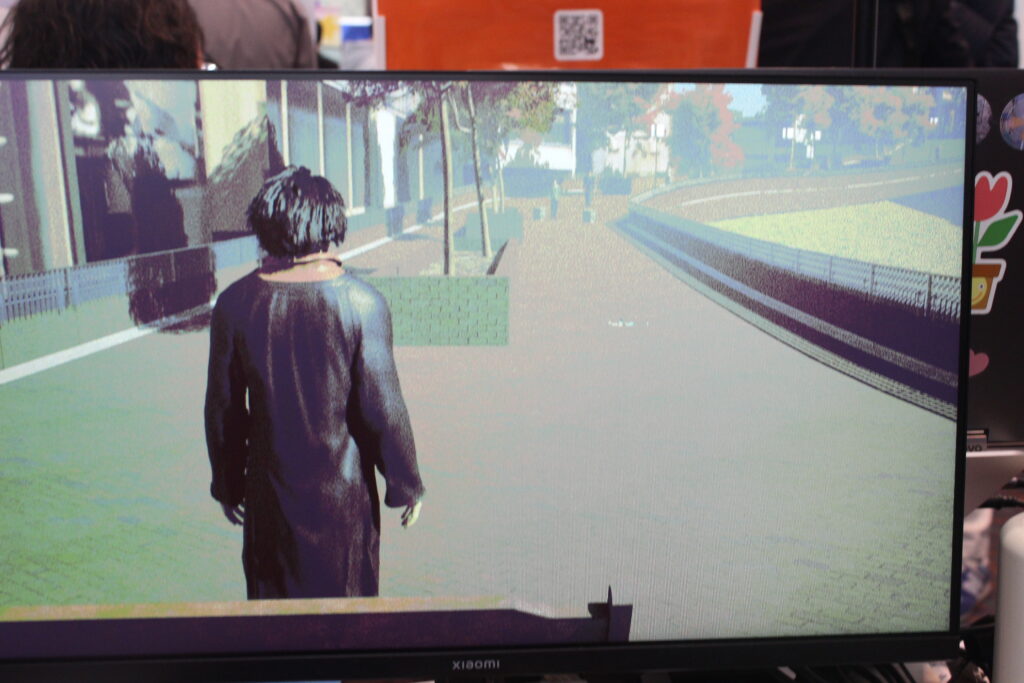
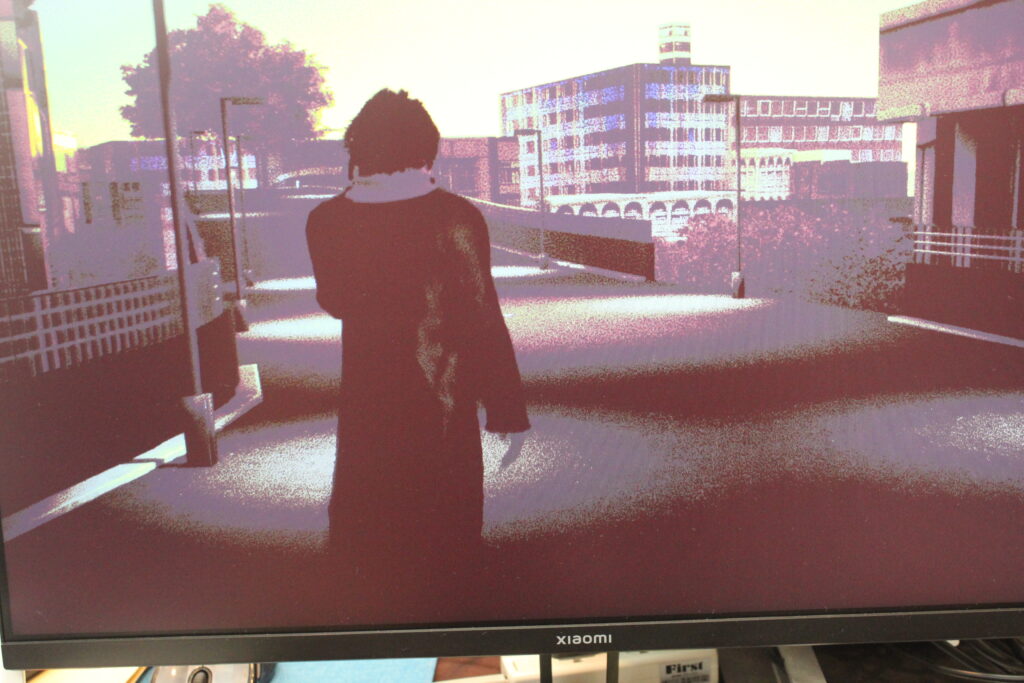
“Would you like to take a 10-minute ‘walk’?” This game, 「A Passing in the Night」, caught my attention with its booth’s catchphrase. True to its words, the demo of this game is simply a 10-minute walk, where you walk while on a phone call. Despite the basic controls being just moving, or moving the joystick on the controller, it left a very deep impression.
The part described on Steam as “where reality and nightmares intertwine” might be the most crucial aspect of this game. Initially, the cityscape that seemed real suddenly encounters absurd non-reality (like a giant foot coming from somewhere and striking the ground towards the protagonist), and the player, who had been feeling somewhat calm, begins to notice this change and immerses themselves in the game world.
While not much was learned through this cinematic-like development, like well-crafted games, it instilled a sense of frustration and anticipation of “I can’t help but wonder what happens next.”
As mentioned earlier, there are no special controls in this game. However, I thought it was good that when controlling with the controller, you could determine the direction of the screen with the right joystick. This is because the unique graphics and the wide map combined to create a very beautiful cityscape that could be seen in the game.
Personally, as someone who enjoys walking, I prioritize seeing the cityscape, so I believe this walk at the event was very successful in meeting my needs.
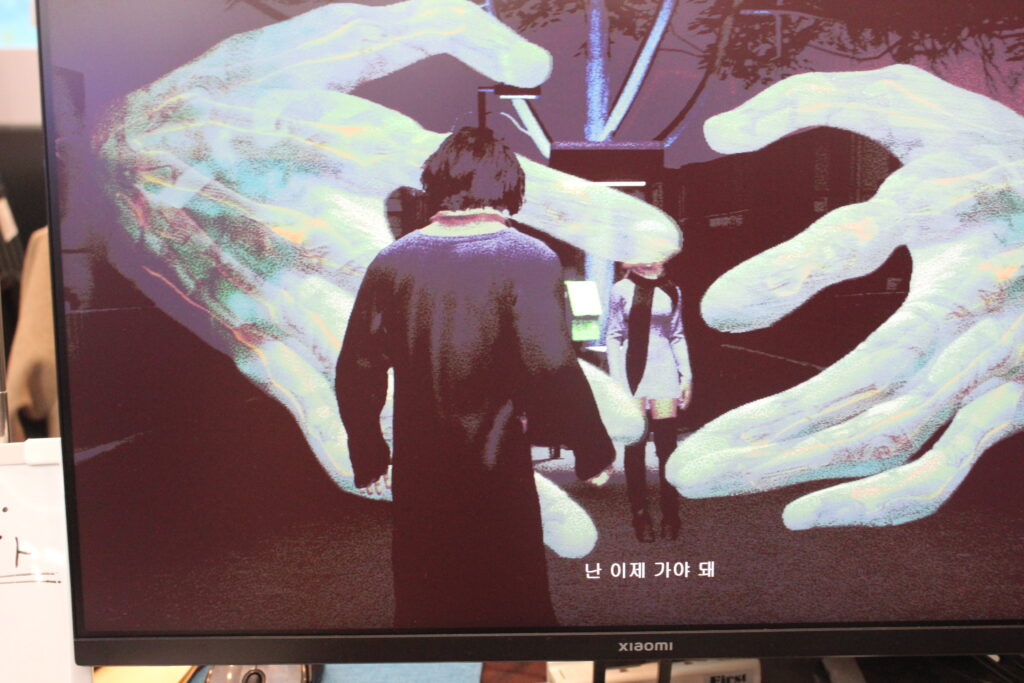
One additional note about the game content: there is a section where you can choose options based on the conversation content, but I thought it was nice that the story progresses even if you don’t select any options at that time, which adds to the immersion in the conversation.
Visually, the aforementioned scenery was impressive. Starting from dusk and flowing into night, the sunset view from the bridge was magnificent.
As for the auditory elements, the voices stand out. This game supports Japanese, English, and Korean, and remarkably, all languages had voice acting in this demo. It’s noteworthy that voice dubbing, which usually requires a considerable scale, was implemented in an indie game.
While it’s hard to predict how the actual game will turn out when released, the voices I heard at the event felt natural, as if I were eavesdropping on a passerby’s phone conversation. Considering that this can be enjoyed in other languages, I can’t help but look forward to its future release. This is just my expectation, though.
ダレとカレも―「ボタン押すだけ」で生まれる認識の歪み
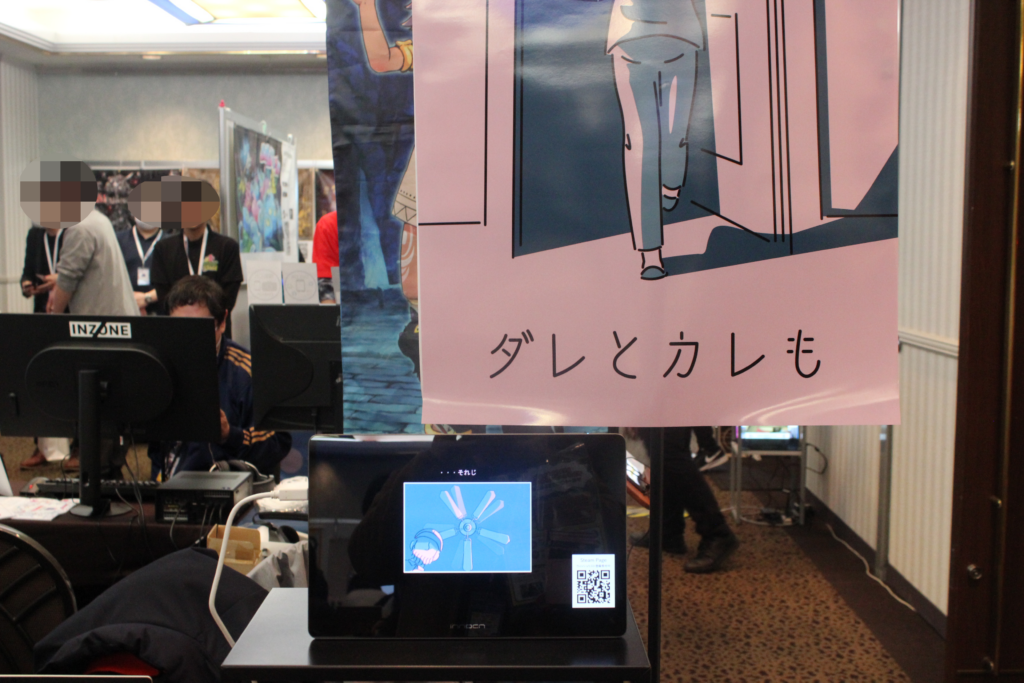
If I had to name the game that shocked me the most at this event, it would undoubtedly be 「ダレとカレも」. First, let me say this: this game is simply about pressing the “button” displayed on the screen. However, due to the surrounding circumstances and the information displayed on the game screen, we end up performing actions that we don’t particularly need to do.
This might be what the game describes as “distortion” on its Steam page. For example, while playing, a message saying “Please enter a valid email address” appears along with an email input field. Naturally, when I reach for the keyboard to input something, instead of entering anything, the message “Please press the button on the screen” gradually fills in the left corner of the screen.
The game guides the player to distort their perception and even interacts with their distorted behavior… It felt like being danced around in the palm of someone’s hand, yet strangely, I didn’t feel uncomfortable; rather, I found it amusing. Various puzzle formats appeared occasionally, but fundamentally, the only operation required was the aforementioned “pressing the button.”
Let me explain why I think this is truly amazing. Pressing the button displayed on the screen. What kind of enjoyment can players derive from this action? Such a simple control mechanism always carries the risk of being perceived as “just boring.” However, this game seems to have meticulously calculated its controls to ensure that players find joy in searching for and pressing buttons, rather than feeling bored.
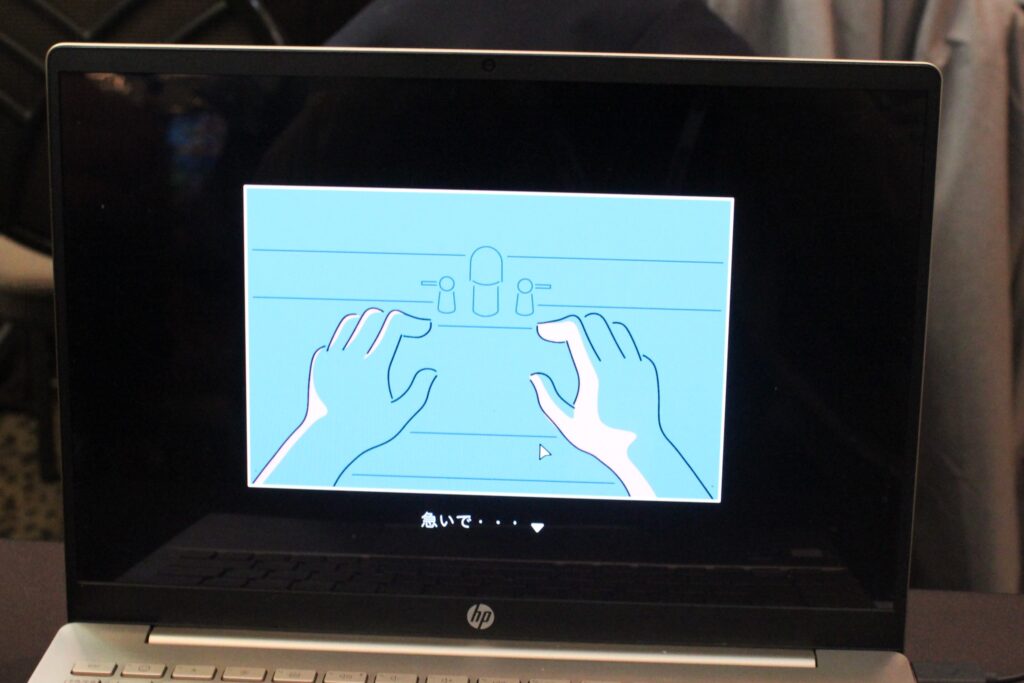
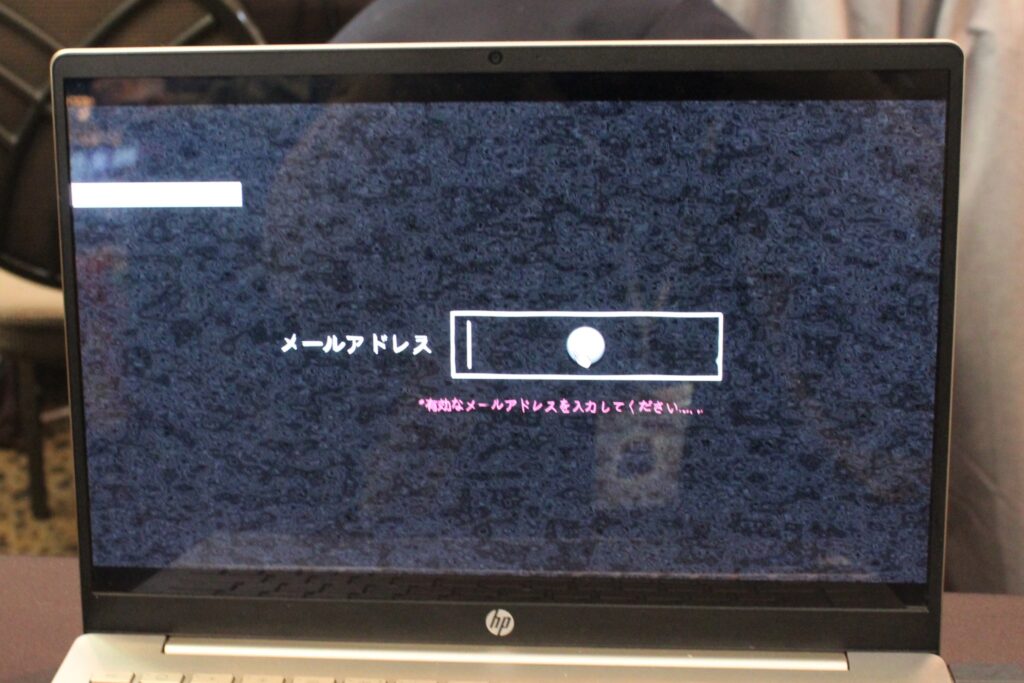
This game made me feel that simple controls must be constructed with the most meticulous and complex thinking. Therefore, this game is designed to easily draw out the player’s “distortion” while simultaneously making it unavoidable. Every time I see such things, I think, “Simplicity is best.” At the same time, it is not something that anyone can do. I was deeply impressed by the structure that, while being admirable, cannot be easily imitated.
Additionally, to avoid misunderstandings, I want to add that this game is not just a title that stands out for its gameplay. Its light yet warm art style (which reminded me of the interactive novel “Florence”) and the detailed yet delicate sound quality were all of a quality that should not be overlooked.
The story is also intriguing, so let me introduce it briefly. The plot unfolds with a mysterious man entering your home after you wake up, claiming, “This is not your home”…! It is scheduled for release on Steam this year, so it seems necessary to keep an eye on it. If there are those who couldn’t experience it at this TIGS, I highly recommend playing it at other events!
TIGS2025を振り返ってみて―ゲームにおける操作性とは
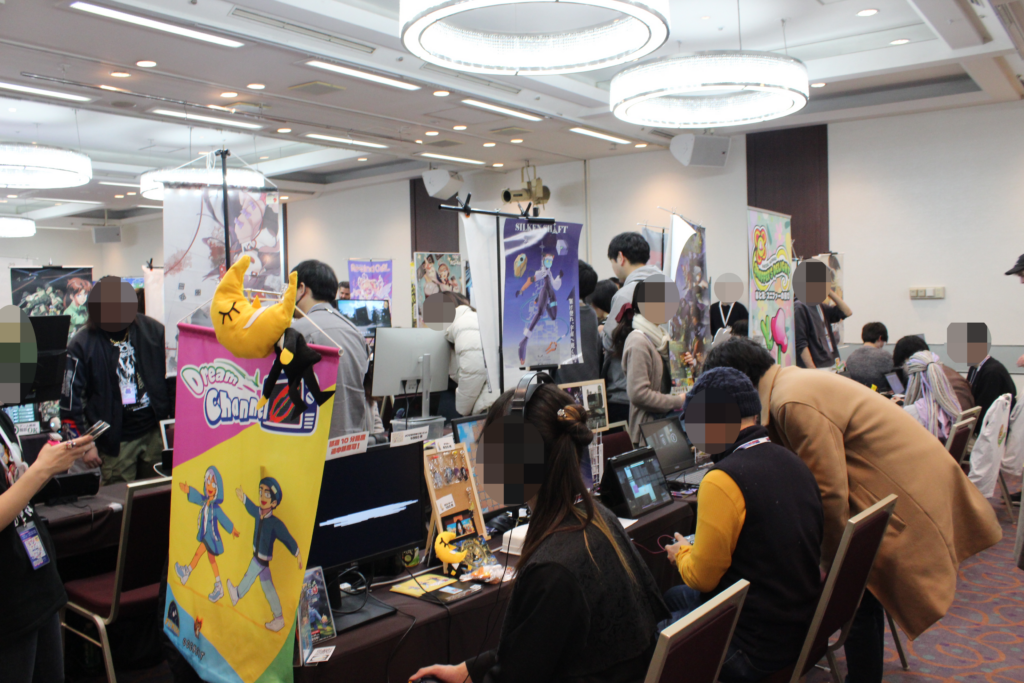
Having introduced five game titles, I realized that when considering the theme of “operability that anyone can achieve,” there are indeed various approaches.
The protagonist shaped like a nose, who embarks on an adventure while inhaling the scent of flowers in 『鼻と花:スニファーの喜び』, combines intuitive controls with nostalgic game design, making it enjoyable even for first-timers.
『I Write Games Not Tragedies』, which depicts inner growth alongside music, taught us that a simple combination of narrative parts and rhythm games can express complex psychological portrayals.
『FREEZIA』, which manages humanity’s frozen sleep, showcased a remarkable balance between simple up-and-down controls and a mysterious dystopian world experience.
『A Passing in the Night』 demonstrated the potential for a simple act of just walking to be transformed into an incredibly rich experience.
And 『ダレとカレも』 was a challenging attempt to question our very perception through the simplest operation of “pressing a button.”
Each game successfully encapsulated a deep gaming experience within simple controls. The notion that “anyone can play” does not equate to “shallow”; rather, it may represent a highly advanced achievement born from repeated ingenuity within those constraints.
By the way, we at SKOOTAGAMES also showcased our new titles 『Mandragora Seeker in the Creep Zone』 and 『太ももうさぎのCash me or Crash me!!』 at this TIGS. However, our games may not align with the theme of this article, so I will discuss them on another occasion.
How’s the progress on Negolove?… I hope to see you at some event later. Well, it’s about time, so I’ll take my leave here for today’s report. See you again.
